Victorian Brides: The wedding is an important custom among all societies. They bring together two souls who have decided to complement each other based on their love and compassion.
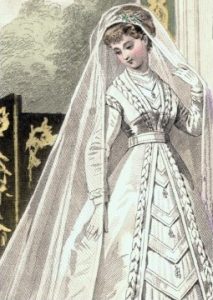
These ceremonies would serve several purposes and are often a cherished moment in the couple’s history.
Victorian Wedding Ceremony
The wedding ceremony is utilized to put up a public display of marriage vows and the guests exhibit the couple’s happy journey as they get into the marital contract. Thus for a bride in the Victorian era the Wedding Day was the most important in her life.
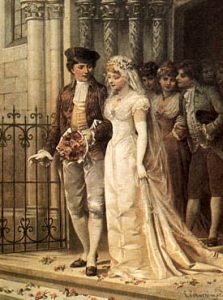
Her mother had prepared her for the day from childhood and the Victorian girl would cherish no greater ambition. Thus, she should marry and marry well.
The Wedding and Traditions
There are numerous traditions that surround the wedding of Victorian brides. The wedding ceremony is steeped in a lot of ancient traditions and they continue the day.
The young girl would play the most important role as most of the ceremony is according to her design. She puts it together by considering the best aspects that she had imagined the ceremony. This begins with her choice of the month and day of the wedding.
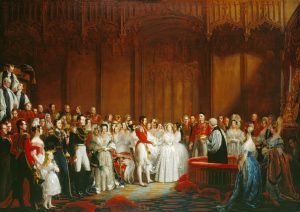
Most have agreed with the month of June, as it had been named after the Roman goddess Juno of marriage. She is known to bring happiness and prosperity to those who wed in the month. June was also a good choice keeping in mind that it was the arrival of warmer weather.
May was considered unlucky – “Marry in May and rue the day”, while with September – “Marry in September’s shine, your living will be rich and fine.” The Victorian bride would even be superstitious about the day of the week in accordance with a popular rhyme:
Marry on Monday for health,
Tuesday for wealth,
Wednesday the best day of all,
Thursday for crosses,
Friday for losses, and
Saturday for no luck at all.
The Wedding Ensemble
Soon after the groom has conferred upon her the prerogative, the Victorian bride would begin planning the trousseau, which surrounded the most important part, the wedding dress. Brides have not always worn white during their wedding.
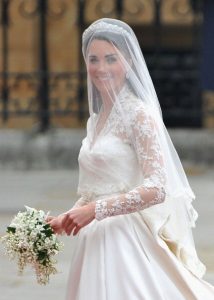
Girls in their teens in the 16th and 17th century would wear pale green to mark their fertility. The mature ladies would wear brown and the older women even preferred black. Up until the 18th century, the poorer brides came to the wedding in white. It was believed the color of the gown would influence the future.
- White–chosen right
- Blue–love will be true
- Yellow–ashamed of her fellow
- Red–wish herself dead
- Black–wish herself back
- Grey–travel far away
- Pink–of you he’ll always think
- Green-ashamed to be seen
But ever since the wedding of Queen Victoria in 1840, white has been the traditional color of wedding dresses and even bouquets. The early Victorian wedding dress would be fitted with the bodice, a small waist, and a full skirt. The dresses would be made of organdy, lace, silk, gauze, tulle, cashmere and linen.
Victorian Brides
The veil would be made out of sheer cotton, fine gauze or veil. Formal weddings during the Victorian period were all white and included the dresses of the bridesmaid and the veil. The veils would be attached to a coronet of flowers, usually, those that bloom in the season.
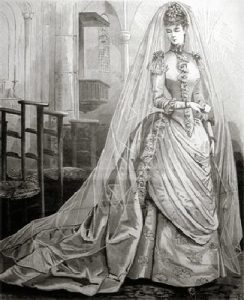
The emergence of wealth in the middle-class families portrayed them with a display of riches. The wedding ensemble would now feature full court trains, long veils, elegant details among others. This bustle disappeared among the late Victorians with a demi-train and large sleeves.
Wedding Dresses In Victorian Era
The dress had to have a train with a veil of the same length if the bride married in a church. The veil would cover the face of the bride and would be revealed only after church. The white kid gloves would be long enough to be tucked under the sleeves and had slits to slip the ring on the finger.
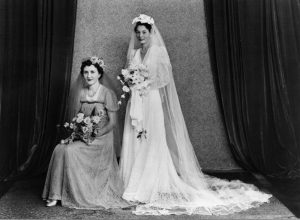
The widow who remarried did not have any bridesmaids, would not wear white and have no veil or orange blossoms. In the later decades, the widows could wear a shade or two away from white, like salmon, rose or ivory, but not allowed the veil or orange blossoms, which were signs of purity.
Other Traditions
Then there was obviously the English rhyme – “Something old, something new, something borrowed, something blue, and a lucky sixpence in your shoe.” The ‘something old’ often could be the family heirloom that she inherited. The ‘something new’ could be the wedding dress of the Victorian brides or a gift obtained from the groom.
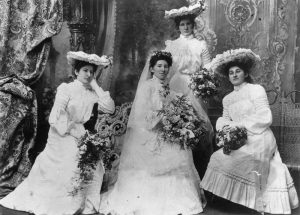
The ‘something borrowed’ mostly used to be a veil or headpiece that was returned to the rightful owner after the ceremony, while the ‘something blue’ would often be an embroidered handkerchief.
The blue color symbolized faithfulness, and the sixpence in the shoe ensured future wealth. The Victorian brides was often a symbol of the beauty and prosperity that marked the era.
More Info On- Victorian Wedding Lore and Superstition, Wedding Ceremony, Wedding Attire, Marriage Customs